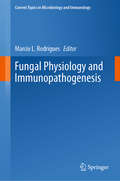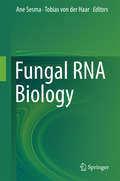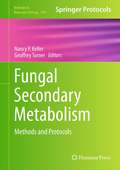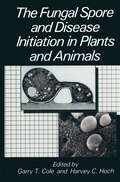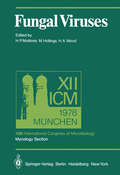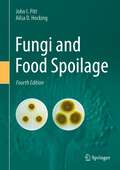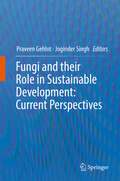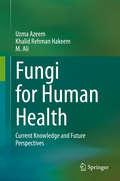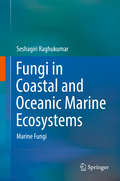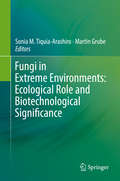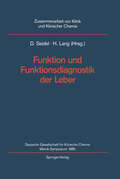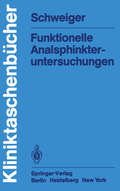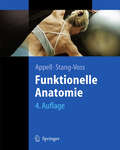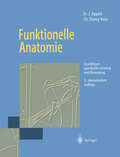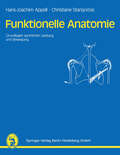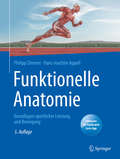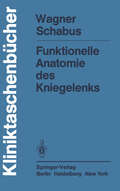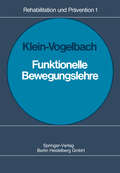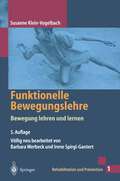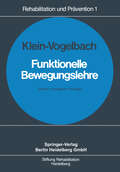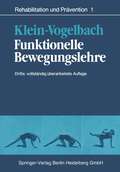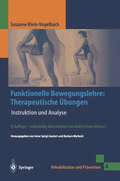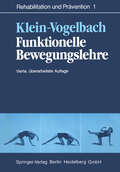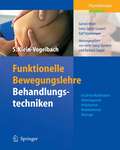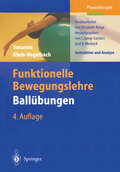- Table View
- List View
Fungal Physiology and Immunopathogenesis (Current Topics in Microbiology and Immunology #422)
by Marcio L. RodriguesThis volume offers an overview of the various aspects involved in the ability of fungi to damage host cells, and discusses cutting-edge approaches to the study of fungal pathogenesis. The first chapter illustrate the key roles of glycans and pigments, the most abundant surface components in fungal cells, in their interactions with host cells. The connections between cellular physiology and fungal pathogenesis are then discussed in the following chapters. Physiology-related processes affecting pathogenesis include fungal secretion, morphological transitions, and response to light. In turn, the book illustrates mechanisms of damage to host cells using the Histoplasma capsulatum model of infection, and reviews the use of transcriptomic approaches to understand the mechanisms of interaction between fungal cells and host tissues. After a discussion of the immunological mechanisms underlying host susceptibility to fungal infections, the book’s closing contribution reviews the mechanisms of interaction between fungi and other microbes, and the impact of this association on fungal pathogenesis. Given its scope, the book will appeal to scientists in the fields of mycology, microbiology, infectious diseases, biology and medicine.
Fungal RNA Biology
by Ane Sesma Tobias HaarThis book presents an overview of the RNA networks controlling gene expression in fungi highlighting the remaining questions and future challenges in this area.It covers several aspects of the RNA-mediated mechanisms that regulate gene expression in model yeasts and filamentous fungi, organisms of great importance for industry, medicine and agriculture. It is estimated that there are more than one million fungal species on the Earth. Despite their diversity (saprophytic, parasitic and mutualistic), fungi share common features distinctive from plants and animals and have been grouped taxonomically as an independent eukaryotic kingdom. In this book, 15 chapters written by experts in their fields cover the RNA-dependent processes that take place in a fungal cell ranging from formation of coding and non-coding RNAs to mRNA translation, ribosomal RNA biogenesis, gene silencing, RNA editing and epigenetic regulation.
Fungal Secondary Metabolism: Methods and Protocols (Methods in Molecular Biology #944)
by Nancy P. Keller and Geoffrey TurnerFilamentous fungi have long been known for their ability to produce an enormous range of unusual chemical compounds known as secondary metabolites, many of which have potentially useful antibiotic or pharmacological properties. Recent focus on fungal genomics coupled with advances in detection and molecular manipulation techniques has galvanized a revitalization of this field. Fungal Secondary Metabolism: Methods and Protocols is aimed at providing the key methodologies currently in use and necessary for accessing and exploiting the natural product information provided by the genomes of this large and varied kingdom. Written by active researchers in the field, the chapters deal with all the steps necessary, from optimization of fungal culture conditions for metabolite production, through rapid genome sequencing and bioinformatics, and genetic manipulations for functional analysis, to detection and testing of metabolites. In addition, chapters on basic science address approaches to the genetic regulation, protein biochemistry, and cellular localization of the biosynthetic pathways. Written in the highly successful Methods in Molecular Biology™ series format, chapters include introductions to their respective topics, lists of the necessary materials and reagents, step-by-step, readily reproducible laboratory protocols, and tips on troubleshooting and avoiding known pitfalls. Practical and hands-on, Fungal Secondary Metabolism: Methods and Protocols encourages new investigators to enter the field and expands upon the expertise and range of skills of those already researching fungal natural products.
The Fungal Spore and Disease Initiation in Plants and Animals
by G. T. Cole H. C. HochThis treatise is focused on early aspects of fungal pathogenesis in plant and animal hosts. Our aim in choosing the topics and contributors was to demonstrate common approaches to studies of fungal-plant and fungal-animal interactions, particularly at the biochemical and molecular Ievels. For example, the initial events of adh«sion of fungal spores to the exposed surface tissues of the host are essential for subsequent invasion of the plant or animal and establishment of pathogenesis. A point of consensus among investigators who have directed their attention to such events in plants, insects, and vertebrates isthat spore adhesion to the host cuticle or epithelium is more than a simple binding event. lt is a complex and potentially pivotal process in fungal-plant interactions which "may involve the secretion of ftuids that prepare the infection court for the development of morphological stages of the germling" and subsequent invasion of the host (Nicholson and Epstein, Chapter 1). The attachment of the fungal propagule to the arthropod cuticle is also "mediated by the chemical components present on the outer layer of the spore wall and the epicuticle . . . . Initial attachment may be reinforced further by either the active secretion of adhesive materials or the modification of spore wall materiallocated at the [fungal spore arthropod] cuticle interface (Boucias and Pendland, Chapter 5).
Fungal Viruses: XIIth International Congress of Microbiology, Mycology Section, Munich, 3–8 September, 1978 (Proceedings in Life Sciences)
by H. P. Molitoris M. Hollings H. A. WoodXII. International Congress of Microbiology, Mycology Sect., Munich, 3-8 September, 1978
Fungi and Food Spoilage
by John I. Pitt Ailsa D. HockingThe first three editions of Fungi and Food Spoilage established, then consolidated, a reputation as the leading book on foodborne fungi. It details media and methods for isolation and identification, descriptions of species, and information on their physiology, ecology and mycotoxin formation. It is an invaluable reference for food microbiologists investigating fungal food spoilage problems, both in field crops and processed foods, and the likelihood of mycotoxin production in either.The Fourth Edition incorporates major differences from the Third: multiple changes in nomenclature due to changes in the International Code of Nomenclature for algae, fungi and plants; many taxonomic changes due to improvements in, and more widespread application of, molecular methods in taxonomy; the introduction of colour colony photographs where appropriate; and a new chapter on mycotoxins.The introductory chapters of the book deal with the ecology of food spoilage, and provide an overview of how food processing, packaging and storage parameters influence fungal growth. A subsequent chapter overviews the fundamentals of naming and classifying fungi. Morphological methods and media suitable for low cost and effective isolation, enumeration and identification of foodborne fungi are provided, together with many more specialised media and techniques. The major part of the book provides keys, descriptions and illustrations of all yeasts and filamentous fungi commonly encountered in foods. Other known characteristics of the species, including physiology and ecology are included. Chapters on the types and species of fungi likely to be found in fresh, harvested and variously processed foods are followed by a new chapter on mycotoxins, both major and minor, their sources, both fungal and food, and their implications for human health.The broad and practical nature of the coverage will appeal to microbiologists, mycologists and biotechnologists in the food industry, as well scientists in academic, research and public health institutions.Drs Pitt and Hocking worked for CSIRO Food for more than 100 years combined. Both are now retired from CSIRO: Dr Pitt continues to work part time with Microbial Screening Technologies, a biodiscovery company.
Fungi and their Role in Sustainable Development: Current Perspectives
by Praveen Gehlot Joginder SinghThis book illustrates the multiple roles of fungi in everyday life. Fungi are the large group of organisms with tremendous diversity and economic importance. Their ability to produce commercially efficient useful products makes them the vulnerable sustainable tool for the future generation. This book describes a systems approach and provides a means to share the latest developments and advances about the benefits of fungi including their wide application, traditional uses, modern practices, along with designing of strategies to harness their potential. The chapters are organized with data, providing information related to different sustainable aspects of fungi in agriculture, its cultivation and conservation strategies, industrial and environmental utilization, advanced bioconversion technologies and modern biotechnological interventions. Updated information and current opinion related to its application for sustainable agriculture, environment, and industries as futuristic tools have been presented and discussed in different chapters. The book also elucidates a comprehensive yet a representative description of the challenges associated with the sustained application of fungi to achieve the goals of sustainability.
Fungi for Human Health: Current Knowledge and Future Perspectives
by Uzma Azeem Khalid Rehman Hakeem M. AliCurrent research lays emphasis on exploring natural products for use in nutraceuticals and pharmaceuticals to overcome various side effects of synthetic drugs. Fungi occupy an eminent position among natural sources of food and medicinal importance since ancient times. Many fungal species have been eaten as food and used in folk medicine for the treatment of many human ailments as mentioned in traditional medical literature. However, scanty information is available pertaining to the nutraceutical and pharmaceutical importance of fungi which merits an extensive review. This book spotlights the use value macrofungi in human health. Macrofungi with health benefitting properties largely belong to Basidiomycota followed by Ascomycota growing indoor (cultivated) and outdoor (wild). We endeavoured to throw light on the benefits of macrofungal taxa in relation to their food and medicinal significance in human life. We provided knowledge pertaining to the ethnomycological significance of macrofungi with respect to their uses as food and medicine by the people inhabiting different parts of the world. This book highlights the nutritional composition and bioactive compounds present in macrofungi. We also focused on the pharmacological activities of macrofungi contributing towards their medicinal value against several human disorders. We cited many commercially available nutraceutical and pharmaceutical products of macrofungal origin. This work will hopefully serve as a basic reference for general public, mycologists, researches and industry men, interested in consumption, research and marketing of macrofungi.
Fungi in Coastal and Oceanic Marine Ecosystems: Marine Fungi
by Seshagiri RaghukumarThis book offers an ecosystem-oriented overview of the diversity, ecological role, and biotechnological applications of marine fungi as well as an in-depth introduction to the marine environment, fungal classification, and ecological principles. It also presents the latest research findings on coastal marine and oceanic ecosystems, such as mangrove, seagrass, salt marsh, algal, coral reef and benthic ecosystems. Focusing on the diversity of fungi as well as their role as symbionts, parasites and saprotrophs, the book also discusses the physiology and biotechnological applications of fungi and highlights topics of future interest. Intended for students and researchers in marine biology and microbiology, it includes detailed descriptions, illustrations, figures, tables, and exhaustive literature citations. A detailed chapter on methods used to study marine fungi, their classification and ecological principles is of particular interest to newcomers in the field.
Fungi in Extreme Environments: Ecological Role and Biotechnological Significance
by Sonia M. Tiquia–Arashiro Martin GrubeOver the last decades, scientists have been intrigued by the fascinating organisms that inhabit extreme environments. These organisms, known as extremophiles, thrive in habitats which for other terrestrial life-forms are intolerably hostile or even lethal. Based on such technological advances, the study of extremophiles has provided, over the last few years, ground-breaking discoveries that challenge the paradigms of modern biology. In the new bioeconomy, fungi in general, play a very important role in addressing major global challenges, being instrumental for improved resource efficiency, making renewable substitutes for products from fossil resources, upgrading waste streams to valuable food and feed ingredients, counteracting life-style diseases and antibiotic resistance through strengthening the gut biota, making crop plants more robust to survive climate change conditions, and functioning as host organisms for production of new biological drugs. This range of new uses of fungi all stand on the shoulders of the efforts of mycologists over generations. The book is organized in five parts: (I) Biodiversity, Ecology, Genetics and Physiology of Extremophilic Fungi, (II) Biosynthesis of Novel Biomolecules and Extremozymes (III) Bioenergy and Biofuel synthesis, and (IV) Wastewater and biosolids treatment, and (V) Bioremediation.
Funktion und Funktionsdiagnostik der Leber: Merck Symposium der Deutschen Gesellschaft für Klinische Chemie, Göttingen, 16. - 18. Mai 1985 (Zusammenarbeit von Klinik und Klinischer Chemie)
by M. NauckD. Seidel Meine sehr verehrten Damen und Herren, liebe Kollegen! Der Inhalt und die Gestaltung sowie die Geschichte der vergangenen Merck-Symposien erklaren ihre Philosophie und Ziele: die Diskus sion ausgewahlter Kapitel der Pathobiochemie einem Kreis von Interessierten und Spezialisten in angenehmer Umgebung zu ermog lichen. Der Merck-Stiftung sei hierflir gedankt. In ihrem Vorwort des tiberaus wertvollen und viel beachteten Lehr buchs der Pathobiochemie schreiben die Herausgeber Karlson, Gerok und Gross: "Die Pathobiochemie ist die Lehre von den Storungen in den bio chemischen Ablaufen im menschlichen Organismus. Durch die Fort schritte der Biochemie in den letzten Jahrzehnten wurden manche Krankheiten als molekulare Krankheiten erkannt: wir konnen ihre Ursachen bis in das molekulare Geschehen hinein verfolgen. Bei vielen anderen Krankheiten mUssen wir uns heute damit begnUgen, die biochemischen Storungen zu beschreiben; aber daraus allein ergeben sich oft wertvolle Hinweise fUr Diagnostik und Therapie. " Das sinnvolle und befruchtende Gesprach tiber ein pathobiochemi sches Thema setzt das Zusammenwirken verschiedener wissenschaft licher Disziplinen voraus. Nur durch die kritische WUrdigung und PrUfung von Einzelaspekten und Erkenntnissen kann sich das um fassende Bild ergeben. Wir wissen heute langst, daB die Patho biochemie zu vielfaltig ist, als daB sie ein "KUnstler" (Wissen schaftler) allein zu malen vermochte. Die an der Krankheit orien tierte klinische Forschung ist mUhsam, aber durchaus reizvoll und fasziniert Neugierige unvergleichlich; sie verdient Zuwendung und viel mehr UnterstUtzung als ihr vielerorts und hierzulande gewahrt wird.
Funktionelle Anatomie: Grundlagen sportlicher Leistung und Bewegung
by Hans-Joachim Appell Christiane Stang-VossFunktionelle Anatomie: Grundlagen sportlicher Leistung und Bewegung
by Hans-Joachim Appell Christiane Stang-VossFunktionelle Anatomie: Grundlagen sportlicher Leistung und Bewegung
by H.-J. Appell C. Stang-Voss"Was man nicht weiß, das eben brauchte man, und was man weiß, kann man nicht brauchen. " Dieses Wort aus Goethes "Faust" spiegelt ange sichts des heterogenen Schrifttums zu den anatomischen Grundlagen des Sports wohl treffend die Lage wider, in der sich Lehrende und Ler nende in diesem Bereich befinden. Die hauptsächlich für Mediziner ver faßten Lehrbücher der Anatomie behandeln das Fach überwiegend nach deskriptiven und topographischen Gesichtspunkten, andere "Sportanatomien" scheinen gelegentlich im Bestreben nach Praxisnähe allzu populärwissenschaftlich verlaßt. Dies war Anlaß genug, den außerordentlich umfangreichen Stoff der Anatomie des Bewegungs apparates, des Nervensystems (soweit für die Motorik wichtig) und der Organsysteme unter funktionellen Gesichtspunkten für den Sport dar zustellen. Die gewählte Vorgehensweise beschränkt sich nicht nur auf das "Wie", sondern versucht - wo möglich und nötig -, auch das "Warum" zu erläutern. Notwendigerweise mußten Kompromisse zwi schen Vollständigkeit und Übersichtlichkeit gemacht werden. So wur den die histologischen Grundlagen nur für die Gewebe des aktiven und passiven Bewegungsapparates ausführlicher behandelt und in den ande ren Kapiteln, sofern zum Verständnis der Funktion erforderlich, nur kurz umrissen. Die Darstellung des Zentralnervensystems orientierte sich eng an der Motorik, wobei die Abhandlung anatomischer Einzel heiten hinter den physiologischen Funktionszusammenhängen zurück stehen mußte. Auch das Kapitel über die Organsysteme konnte nur jene berücksichtigen, die für weiterführende Studien zur Anpassung des Organismus an Leistung innerhalb der Sportmedizin von Bedeutung sind. Die Beantwortung der Fragen nach biochemischen und komplexen physiologischen Prozessen muß den Lehrbüchern jener Disziplinen vor behalten bleiben.
Funktionelle Anatomie: Grundlagen sportlicher Leistung und Bewegung
by Philipp Zimmer Hans-Joachim AppellWie funktioniert der menschliche aufrechte Gang? Welche Muskeln sind beteiligt? Wie werden die auf den Fuß einwirkenden Kräfte beim Lauf abgefedert? Experten erläutern hier alle grundlegenden und wichtigen Details zu Aufbau und Funktion des menschlichen Körpers: das Zusammenspiel der Bestandteile des Bewegungsapparates – Knochen, Sehnen und Muskeln, die Bewegungssteuerung und -kontrolle durch das Zentrale Nervensystem sowie alle für sportliche Leistung und Bewegung notwendigen Körpersysteme.Die 5. Auflage wurde komplett überarbeitet und enthält Prüfungsfragen, die über die App Springer Nature Flashcards abgerufen werden können. Der eigene Wissenstand zu einem Thema kann mittels Fragen und Antworten einfach und spielerisch abgefragt werden.
Funktionelle Bewegungslehre (Rehabilitation und Prävention #1)
by S. Klein - Vogelbach"Menschen leben nicht in einem allgemeinen Sinne, sondern immer im Sinne einer Verhaltensänderung, die sich in beobacht baren Formen menschlicher Leistung beschreiben läßt. " ROBERT M. GAGNE Das vorliegende Lehrbuch der "Funktionellen Bewegungs lehre" von Susanne Klein -Vogelbach bestätigt diese Annah me in doppelter Hinsicht: Erstens prägen die Lehrinhalte das kognitive und soziale Verhalten des Physiotherapeuten (Internationale Bezeichnung für das deutsche Berufsbild des Krankengymnasten), definie ren seine fachspezifischen Fertigkeiten und strukturieren da mit die therapeutischen Situationen. Zweitens geben die Lehrinhalte zusammen mit ihrer didakti schen Aufbereitung den kranken und behinderten Menschen die Möglichkeit, in der therapeutischen Situation einen aktiven, individuell angemessenen Lernprozeß im Umgang mit seinen vorübergehend geschädigten oder langfristig veränder ten Funktionen durchzumachen. Um überhaupt die Phänomene der Statik und Bewegung des menschlichen Körpers, sowohl in seinen hypothetischen Normen als auch in seinen pathologischen Abweichungen wahrzunehmen und interpretieren zu können, bedarf es einer sorgfältig geplanten Schulung des Physiotherapeuten. Die Verfasserin hat der Notwendigkeit grundlegender fach spezifischer Fertigkeiten detailliert Rechnung getragen. Aus langjähriger praktischer Erfahrung im Umgang mit Patienten einerseits und in der Diskussion mit ihren Schülern anderer seits entstand dieses Lehrbuch, das erstmalig das kognitive und soziale Verhalten des Therapeuten in bezug auf einen Lehr stoff definiert, den sie selbst geschaffen hat.
Funktionelle Bewegungslehre: Bewegung lehren und lernen (Rehabilitation und Prävention #1)
by Susanne Klein-VogelbachVon B. Werbeck und I. Spirgi-Gantert völlig neu bearbeitet und inhaltlich wie formal rundum modernisiert:- besser lesbar und leichter zugänglich- mit farbigen Lernhilfen und Zeichnungen- praxisbezogen durch zahlreiche Beispiele- Neu: Grundlagen der Gangschulung und Ausblicke auf Behandlungstechniken und ÜbungenAls Standardwerk in der Physiotherapie leitet es Therapeuten in der Ausbildung an,o normale und von der Norm abweichende Bewegung und Haltung präzise zu beobachten,o dem Patienten in der Behandlung richtiges Bewegungsverhalten zu vermitteln undo seine aktive Wahrnehmung dafür zu schulen.
Funktionelle Bewegungslehre: Instruktion und Analyse (Rehabilitation und Prävention #4)
by Susanne Klein-VogelbachMit den "Therapeutischen Übungen" werden die Grundlagen der Funktionellen Bewegungslehre Klein-Vogelbach in die Praxis umgesetzt. Das Lehrbuch bietet: *eine Schritt für Schritt-Anleitung für die Durchführung jeder Übung, *ein klar festgelegtes Konzept für die genaue Bewegungsanalyse und *eine Übersicht der Lernziele am Anfang des Buchs, die schnell zur für den einzelnen Patienten richtigen Übung hinführt. In der Neuauflage *sind jetzt alle Übungen, einschließlich der "Gangübungen", in einem Band zusammengefasst; *sind die FBL-spezifischen Fachbegriffe der allgemeinen Terminologie der Physiotherapie angepasst;*ist das Analysenkonzept einfacher und straffer dargestellt und so für Lernende und Therapeuten jetzt leichter zugänglich; *zeigen spezielle Hinweise, worauf man bei jeder Übung besonders achten muss; *sind die Übungssequenzen mit überwiegend neu aufgenommenen Fotoserien noch besser veranschaulicht.
Funktionelle Bewegungslehre: Hubfreie Mobilisation, Widerlagernde Mobilisation, Mobilisierende Massage
by Susanne Klein-Vogelbach Gerold Mohr Irene Spirgi-Gantert Ralf StüvermannDie Behandlungstechniken: Therapiebausteine der FBL Im klassischen Konzept der Funktionellen Bewegungslehre (FBL) Klein-Vogelbach wird die physiotherapeutische Bewegungsschulung bei muskuloskelettalen Beschwerdebildern und anderen Bewegungsdysfunktionen durch die drei hier gezeigten Behandlungstechniken unterstützt: Differenziert: lokale Behandlungsmöglichkeiten nutzen Mit den Behandlungstechniken erlernen Sie den Einsatz manipulativer Hilfen, mit denen Sie unter anderem Elemente der Therapeutischen Übungen der FBL differenziert an das individuelle Bewegungsverhalten und die momentane Belastbarkeit Ihrer Patienten anpassen können. Konkret: direkt für die Praxisanwendung * Ausgangsstellungen, Ausführung und Varianten jeder Technik werden systematisch beschrieben und detailliert bebildert gezeigt. * Optisch betonte Hinweise machen Sie auf Besonderheiten, Indikationen und Kontraindikationen jedes Verfahrens aufmerksam. * Über 280 professionelle Fotos bieten Ihnen eine ideale didaktische Ergänzung zum genauen Erfassen und Nachvollziehen der knappen Textanleitungen. Komplett: die bekannten und neue Techniken Früher schon veröffentlichte und die neu entwickelten Verfahren finden Sie hier zum ersten Mal zusammengefasst und ausführlich dargestellt. Praktisch unentbehrlich: * Für Einsteiger und erfahrene Therapeuten als Handbuch und Nachschlagewerk in der täglichen Arbeit mit Patienten * Als Lehr- und Lernbuch in Unterricht und Fortbildung.
Funktionelle Bewegungslehre Ballübungen: Instruktion und Analyse
by Susanne Klein-Vogelbach Elisabeth BürgeMit dem Ball Bewegung lernen und lehren - dieses Mittel kann man therapeutisch und präventiv wirksam einsetzen: Der Ball fördert Fertigkeiten, die für ein optimales Bewegungsverhalten wesentlich sind, wie Reaktionsfähigkeit, dynamische Stabilisation und ökonomische Aktivität. In der Neuauflage des Lehrbuchs + sind die Bewegungsabläufe leichter verständlich und übersichtlicher als bisher dargestellt; + ist das Analysenkonzept klar gegliedert und auf das für Lernende und Therapeuten Wichtige begrenzt; + illustrieren viele neue und zusätzliche Fotos den Text noch anschaulicher in den Details. Mit diesen Vorzügen regt das Buch ganz direkt zum Bewegungslernen und praktischen Üben mit dem Ball an.
